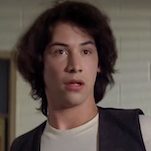5 Scientific Principles That Explain Supergirl‘s Big Ch-Ch-Ch-Changes
(Episode 2.06)
The CW
Change is inevitable. Evolution, whether marked by a dramatic genetic mutation or a subtle shift in perception, is how we’ve survived as a species. But it can be hard. Making sense of an ever-shifting, chaotic universe can leave you with the kind of intergalactic hangover that’ll make you wish you’d stopped at the fourth drink sent to you at an alien bar. Because no matter how hilarious a drunk Supergirl is, actions still have consequences, and making sense of the results is the most important step of all.
So, armed with the knowledge that knowing is way more than half the battle—I’d say it’s a solid 86%—let’s go back to fourth grade science. Back to the scientific principles we once knew by heart. Forgive yourself for forgetting this vital elementary education, because our brains can only store so much, and those Mariah Carey lyrics are important damn it! And forgive our beloved Supergirl cast, too, as we take a look at how the steps of the scientific method could have brought some serious clarity to tonight’s ch-ch-ch-ch-changes.
1. Make an Observation
You’d think this would be the easy part: a simple thought experiment. And sometimes it is. Sometimes the response to your observation is common sense. Like, let’s say you’re working at an isolated research facility in Norway, and someone brings in an ancient frozen wolf corpse, an ancient frozen wolf corpse that just so happens to have the same body temperature as a living creature. You might observe something along the lines of: Well, this is strange.
Maybe don’t stick your hand into something you’ve just observed is a natural anomaly, Dr. Jones. Especially one that you most closely equated with a disease. I mean, come on! Quarantine procedures were invented for a reason. Please excuse my side eye to Alex, Hank and the DEO here, as well.
2. Form a Question
Observation in hand (or hand in wolf), you’re ready to move on to the next step. But don’t just glide into the question phase. This isn’t your eighth grade science fair, and Ms. Baxter isn’t going to accept “Do magnets affect plant growth?” from a fifth student this year.
Make sure that what you’re questioning and what you’re observing is the same thing. For example, you might be asking, “Can I train my troubled fellow alien to become a hero like myself?” And that’s perfectly noble. But what you may have missed in your rush to do more is the very simple observation that your fellow alien has no interest in being a hero. Maybe his interests lie in getting free drinks at bars and roughing up debtors. Maybe the observations you’re making should lead you nowhere near the question you’re asking. And starting your experiment with the wrong question isn’t going to get you very far, Kara. A B- at best.
3. Form a Hypothesis
Observations gathered and question (hopefully) well asked, it’s time for an answer. Not the ultimate answer, obviously, but an educated guess at the very least.
For example:
-

-

-

-

-

-

-

-

-

-

-

-

-

-

-

-

-

-

-

-

-

-

-

-

-

-

-

-

-

-

-

-

-

-

-

-

-

-

-

-








































